- [email protected]
- +254 723 065019
- Mon - Sat 9:00 AM - 5:00 PM
- Login or Register
- Favorites
1.2 Importance of Sustainability in Construction
Lesson 1.2: Importance of Sustainability in Construction
The construction industry plays a vital role in shaping the built environment, but it also has a profound impact on our planet. From the extraction of raw materials to the operation of buildings, the construction sector is responsible for significant resource consumption, energy use, and waste generation. As global challenges like climate change, resource depletion, and urbanization continue to grow, the importance of sustainability in construction has never been greater.
This lesson delves into why sustainability is crucial in the construction industry, highlighting how sustainable practices can address environmental, social, and economic challenges. By adopting sustainable construction methods, we can reduce harmful environmental impacts, improve the quality of life for communities, and drive economic benefits through cost savings and increased property values. Understanding these benefits is essential for industry professionals, policymakers, and stakeholders who are working towards creating a more sustainable future.
In this lesson, we will explore the importance of sustainability from multiple perspectives—environmental, social, and economic—offering insights into how sustainable construction can help build a better world.
Objective:
By the end of this lesson, learners will have a comprehensive understanding of the critical role sustainability plays in the construction industry. They will be equipped with knowledge about how sustainable construction practices can significantly reduce environmental impacts, enhance social well-being, and deliver economic benefits. Learners will recognize that sustainability in construction is not just about meeting regulatory requirements but also about adopting practices that create long-term value for society, the economy, and the environment.
Key Learning Outcomes:
- Environmental Awareness: Learners will understand the environmental challenges posed by traditional construction methods, such as high carbon emissions, resource depletion, and waste generation. They will explore how sustainable construction techniques—like energy efficiency, waste reduction, and the use of renewable materials—can mitigate these impacts, leading to a healthier planet.
- Social Responsibility: Learners will recognize the social benefits of sustainable construction, including improved health and well-being for occupants, enhanced community resilience, and the creation of safer, more inclusive spaces. The lesson will highlight how sustainable buildings can enhance the quality of life through better air quality, natural lighting, and healthier indoor environments.
- Economic Advantage: The lesson will help learners appreciate the economic benefits of sustainable construction, such as cost savings from reduced energy consumption, increased property values, and financial incentives available for green buildings. Learners will understand how sustainability can lead to long-term economic gains, making it a smart investment for developers, businesses, and governments.
- Holistic View of Sustainability: By integrating environmental, social, and economic perspectives, learners will gain a holistic view of how sustainable construction practices contribute to the global sustainability agenda. This understanding will empower them to advocate for and implement sustainable solutions in their own projects, driving positive change within the industry.
- Real-World Applications: Through case studies and practical examples, learners will see how sustainable construction is being applied in real-world scenarios. They will be able to identify successful strategies and understand the potential challenges, preparing them to make informed decisions that align with sustainability goals.
Ultimately, this lesson aims to inspire construction professionals to prioritize sustainability in their projects, understanding that their choices have far-reaching impacts on the environment, society, and economy. By embracing sustainable practices, they can play a pivotal role in shaping a more sustainable future for all.
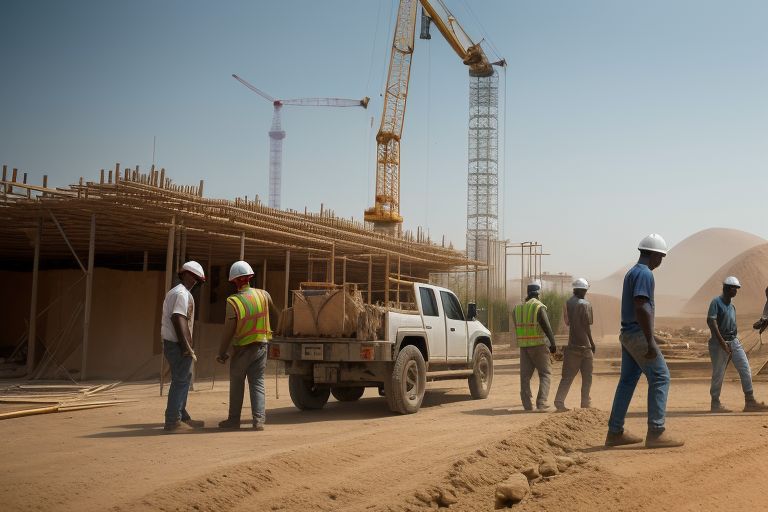
1. Introduction to the Importance of Sustainability
Sustainability has become a crucial element in the construction industry as the world grapples with environmental challenges like climate change, resource depletion, and pollution. The construction sector, known for its significant impact on the environment, plays a pivotal role in addressing these issues. Integrating sustainability into construction is not just a trend; it’s a necessary shift towards more responsible and future-oriented building practices.
In this section, we will explore why sustainability is essential in construction. We will define what sustainability means within this context and examine the reasons it matters so much. Understanding the importance of sustainable construction helps us appreciate how our industry’s actions can either contribute to environmental degradation or lead the way toward a greener, more resilient world. By adopting sustainable practices, construction professionals can minimize their projects’ negative impacts, conserve valuable resources, and create healthier, more efficient, and economically viable buildings.
This section will guide you through the core reasons why embracing sustainability is no longer optional but essential for the future of construction. As we delve into the environmental, social, and economic dimensions of sustainability, you will gain insight into how these practices can transform the way we build and live. Let’s begin by exploring what sustainability in construction truly means and why it matters now more than ever.
Key Points:
a. Defining Sustainability in Construction
Sustainability in construction goes beyond simply creating buildings—it involves a holistic approach that considers the entire lifecycle of a structure, from design and material selection to construction, operation, maintenance, and eventual demolition or repurposing. It encompasses three core pillars:
-
- Environmental Stewardship: Sustainable construction aims to reduce environmental impacts by minimizing waste, conserving natural resources, reducing carbon emissions, and protecting ecosystems. This involves using eco-friendly materials, employing energy-efficient designs, and implementing waste management practices.
- Social Responsibility: The human aspect of sustainability focuses on creating safe, healthy, and inclusive spaces for occupants and the broader community. It includes enhancing indoor environmental quality, using non-toxic materials, engaging local communities in the development process, and ensuring that buildings contribute positively to the social fabric.
- Economic Viability: A sustainable approach ensures that construction projects are not only environmentally friendly and socially responsible but also economically sound. This means reducing operational costs through energy efficiency, maximizing the value of investments, and creating structures that have long-term benefits, such as increased property values and reduced maintenance costs.
Sustainability in construction is about making informed, conscious decisions that balance these three pillars, creating buildings that meet current needs without compromising the ability of future generations to meet theirs.
b. Why It Matters
The construction industry plays a substantial role in shaping our environment, economy, and society. However, traditional construction practices have long been associated with several negative impacts:
-
- High Resource Consumption: The construction sector consumes a significant portion of global resources, including raw materials like timber, metals, and minerals. Unsustainable practices can lead to the depletion of these non-renewable resources, creating a strain on the environment and increasing the industry’s ecological footprint.
- Energy Use and Carbon Emissions: Construction and building operations are responsible for nearly 30% of global energy consumption and contribute a large share of greenhouse gas emissions. The production of construction materials, energy used on-site, and the ongoing operation of buildings all add to the carbon footprint, exacerbating climate change.
- Waste Production: The industry is a major producer of waste, with construction and demolition activities generating vast amounts of debris that often end up in landfills. This waste includes materials like concrete, wood, and metals, which, if not managed sustainably, contribute to environmental pollution.
- Impact on Water, Air, and Soil Quality: Construction activities can significantly impact local water resources through runoff and pollution, degrade air quality through dust and emissions, and harm soil health through contamination and land disturbance. These impacts can have lasting effects on ecosystems and human health.
- Promoting a Healthier Planet: By adopting sustainable practices, the construction industry can dramatically reduce its negative environmental impacts. This involves using sustainable materials, optimizing resource use, and integrating renewable energy technologies. Sustainable buildings are designed to be energy-efficient, reduce waste, and promote cleaner air and water, ultimately contributing to a healthier environment.
Sustainability in construction is not just a regulatory or ethical obligation—it is a strategic approach that addresses the growing demand for greener buildings, improves the quality of life for communities, and ensures that the construction industry can thrive in a resource-constrained world. By prioritizing sustainability, we can create a built environment that supports a sustainable future.
Reflection Element:
Reflect on why sustainability is important in the construction industry.
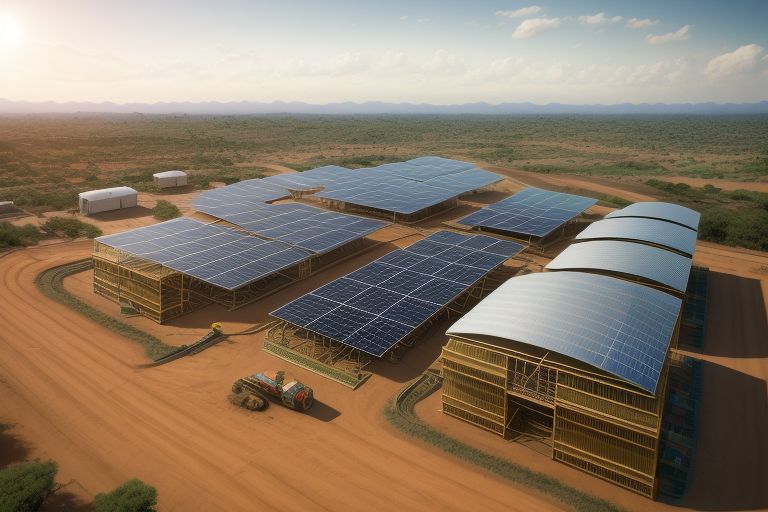
2. Environmental Benefits of Sustainable Construction
Sustainable construction is a powerful tool in the fight against environmental degradation. As one of the largest consumers of natural resources and a significant contributor to global emissions, the construction industry has a unique responsibility—and opportunity—to drive positive environmental change. By adopting sustainable practices, the industry can significantly reduce its ecological footprint, conserve precious resources, and help protect the planet for future generations.
The environmental benefits of sustainable construction go beyond just reducing emissions and conserving energy; they encompass a comprehensive approach to managing resources, minimizing waste, and preserving ecosystems. From the use of energy-efficient building designs and renewable energy sources to the implementation of innovative waste management techniques and the protection of natural habitats, sustainable construction practices contribute to a healthier and more resilient environment.
In this section, we will explore the key environmental benefits of sustainable construction, highlighting how these practices not only mitigate negative impacts but also create positive outcomes for the environment. Understanding these benefits is crucial for recognizing the broader role that the construction industry can play in promoting environmental stewardship and combating climate change.
Key Points:
a. Reducing Carbon Emissions:
Sustainable buildings are designed to consume significantly less energy through advanced energy-efficient systems, high-quality insulation, and the integration of renewable energy sources such as solar panels and wind turbines. By reducing the need for fossil fuel-based energy, these buildings lower greenhouse gas emissions, directly contributing to the fight against climate change. Energy-efficient heating, ventilation, and air conditioning (HVAC) systems, along with energy-saving lighting and appliances, play a critical role in minimizing a building’s carbon footprint over its lifecycle.
b. Conserving Natural Resources:
The construction industry is a major consumer of raw materials, but sustainable practices emphasize the use of eco-friendly alternatives. Materials like recycled steel, bamboo, reclaimed wood, and recycled plastic help decrease reliance on non-renewable resources. By choosing materials with low environmental impact, builders can reduce resource depletion and lower the overall environmental costs associated with extraction, production, and transportation. Additionally, efficient construction methods, such as precision cutting and digital modeling, help minimize material waste, making the most out of available resources.
c. Minimizing Waste:
Construction and demolition activities generate substantial waste, much of which ends up in landfills. Sustainable construction seeks to minimize this waste through innovative strategies such as prefabrication, modular construction, and on-site recycling of materials like concrete, metal, and wood. Prefabricated components, made in controlled environments, reduce on-site waste and allow for more efficient material usage. Modular construction, which involves creating building sections off-site and assembling them on-site, not only cuts down on waste but also speeds up the construction process and reduces overall environmental impact.
d. Protecting Ecosystems:
Construction activities can cause significant disruption to local ecosystems, affecting water quality, soil stability, and native habitats. Sustainable construction practices aim to minimize these impacts by employing strategies that protect and enhance the natural environment. For example, the use of permeable paving allows rainwater to infiltrate the ground, reducing runoff and preventing water pollution. Green roofs and walls not only provide insulation but also create habitats for urban wildlife, supporting biodiversity in built environments. Additionally, careful site planning and the preservation of existing vegetation help maintain natural landscapes and reduce ecological disturbances.
These environmental benefits highlight the critical role that sustainable construction plays in reducing the negative impacts of traditional building methods. By adopting these practices, the construction industry can lead the way toward a more sustainable future, where buildings contribute positively to the environment rather than depleting it.

Case Study Example:
Project: The Edge, Amsterdam, Netherlands
The Edge, located in Amsterdam, Netherlands, is widely recognized as one of the most sustainable office buildings in the world. Completed in 2015, this innovative building was developed by OVG Real Estate and designed by PLP Architecture, setting a new benchmark for sustainable construction. The Edge was awarded a BREEAM (Building Research Establishment Environmental Assessment Method) score of 98.36%, the highest ever awarded, highlighting its commitment to environmental excellence.
a. Sustainable Features:
- Solar Power Integration:
The Edge is equipped with a vast array of solar panels, including those installed on the roof and neighboring buildings, making the building energy-positive. These panels generate more electricity than the building consumes, allowing it to feed excess energy back into the grid. The integration of solar power significantly reduces the building’s reliance on non-renewable energy sources, making it a prime example of how renewable energy can drive down carbon emissions. - Rainwater Harvesting:
To reduce water consumption and promote resource efficiency, The Edge incorporates a sophisticated rainwater harvesting system. Collected rainwater is filtered and reused for various purposes, including irrigation, toilet flushing, and cooling systems. This reduces the building’s demand for potable water and minimizes its impact on local water resources, supporting a sustainable water management strategy. - Smart Energy Management Systems:
One of the standout features of The Edge is its advanced smart energy management system, which uses a network of sensors to monitor and adjust lighting, heating, and cooling based on occupancy and external weather conditions. These sensors collect data on how spaces are used, optimizing energy usage throughout the building. This intelligent system ensures that energy is only used when and where it’s needed, greatly enhancing overall efficiency. - Energy-Efficient Design:
The Edge employs a range of energy-efficient design elements, such as natural ventilation, triple-glazed windows, and high-performance insulation, which help maintain optimal indoor temperatures and reduce the need for artificial heating and cooling. The building’s atrium allows for ample natural light, significantly cutting down on the need for artificial lighting and enhancing the indoor environment for occupants.
b. Environmental Impact and Results:
- Energy Savings:
The Edge uses 70% less energy compared to conventional office buildings of similar size. Its ability to generate more energy than it consumes underscores the effectiveness of combining renewable energy sources with smart building technologies. This level of energy efficiency demonstrates that sustainable buildings can achieve operational excellence without compromising functionality or comfort. - Reduced Carbon Footprint:
By integrating renewable energy systems, minimizing water use, and optimizing resource consumption, The Edge has set a new standard for low-carbon construction. The building’s overall carbon emissions are drastically lower than those of traditional office buildings, showcasing how sustainable design can directly contribute to climate change mitigation.
The Edge serves as a powerful example of how cutting-edge technology and thoughtful design can converge to create a highly sustainable built environment. Its innovative approach to energy management, water conservation, and resource efficiency not only reduces its environmental impact but also enhances the well-being of its occupants. The project illustrates the potential of sustainable construction to redefine the future of buildings, offering a blueprint for reducing carbon footprints and conserving natural resources in the global push toward sustainability.
Reflection Element:
Reflect on ways construction projects in your locality to reduce environmental impacts.
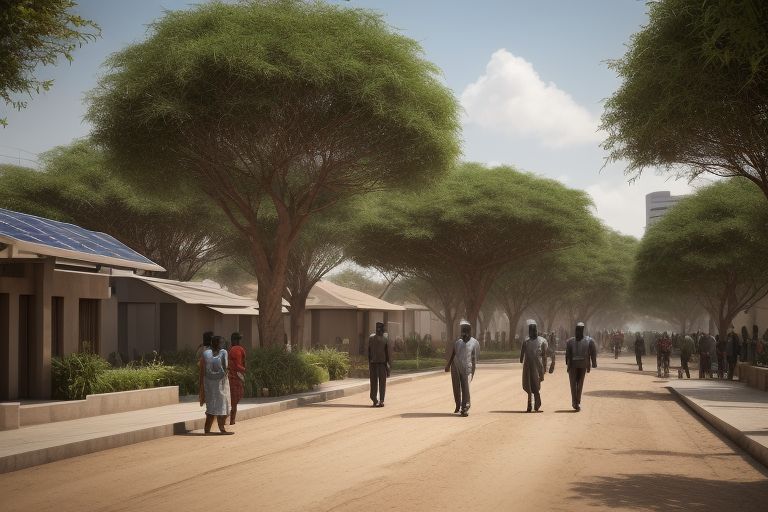
3. Social Benefits of Sustainable Construction
Sustainable construction goes beyond just minimizing environmental impact—it also plays a critical role in enhancing the quality of life for individuals and communities. By prioritizing health, comfort, and well-being, sustainable buildings contribute to creating healthier and more productive environments for occupants. They improve indoor air quality, reduce exposure to harmful materials, and foster social inclusion through thoughtful design that responds to community needs.
Sustainable construction also supports urban resilience, preparing buildings and communities to withstand natural disasters and adapt to changing climate conditions. This section explores how sustainable construction practices provide significant social benefits, improving not just the built environment but also the lives of those who interact with it.
Key Points:
a. Improved Health and Well-Being:
-
- Indoor Air Quality: Sustainable buildings are designed to improve indoor air quality by using low-VOC (volatile organic compounds) materials, non-toxic finishes, and efficient ventilation systems. This reduces exposure to harmful chemicals and pollutants, which can contribute to respiratory issues, allergies, and other health problems.
- Natural Light and Ventilation: Maximizing natural light and providing effective ventilation are key features of sustainable design. These elements not only create pleasant and aesthetically pleasing environments but also support mental well-being by aligning with circadian rhythms and reducing reliance on artificial lighting.
- Ergonomic and Healthy Design: Sustainable buildings often include ergonomic designs and features such as adjustable workstations and wellness areas. These aspects contribute to physical comfort and reduce the risk of musculoskeletal issues, promoting overall health.
b. Enhanced Comfort and Productivity:
-
- Climate Control and Insulation: Advanced climate control systems and high-quality insulation ensure stable indoor temperatures, reducing discomfort from temperature fluctuations. This is particularly important in workplaces and educational settings, where comfort directly impacts productivity and focus.
- Sound Insulation: Sustainable buildings frequently incorporate effective sound insulation to minimize noise pollution. Reduced noise levels enhance concentration, lower stress, and create a more conducive environment for both work and relaxation.
- Optimized Lighting: Energy-efficient lighting systems that mimic natural daylight contribute to better visibility and reduced eye strain. Proper lighting enhances the functionality of spaces and supports productivity by creating a more comfortable and inviting atmosphere.
c. Community Engagement:
-
- Local Collaboration: Sustainable construction often involves engaging with local communities to ensure that new projects address the specific needs and desires of the people who will be affected. This collaborative approach fosters a sense of ownership and inclusion among residents.
- Social Inclusivity: By incorporating features that cater to diverse needs, such as accessible design and community spaces, sustainable buildings promote social inclusivity. These designs ensure that everyone, regardless of physical ability or socio-economic status, can benefit from and contribute to the built environment.
- Empowerment: Involving community stakeholders in the planning and design processes empowers them to influence how their environments are shaped. This participation not only aligns projects with local priorities but also strengthens community bonds and enhances social cohesion.
d. Urban Resilience:
-
- Climate Adaptation: Sustainable buildings are designed to withstand and adapt to extreme weather events and climate change impacts. Features such as flood-resistant foundations, reinforced structures, and green roofs help mitigate damage and support quicker recovery after natural disasters.
- Energy Independence: By integrating renewable energy sources such as solar panels and wind turbines, sustainable buildings reduce their reliance on external energy supplies. This energy independence not only supports resilience but also reduces vulnerability to energy price fluctuations and supply disruptions.
- Ecosystem Protection: Sustainable design often includes strategies to protect and restore natural ecosystems, such as creating green spaces and using permeable materials. These practices help maintain ecological balance and support the overall health of urban environments.
Sustainable construction offers profound social benefits that extend beyond the immediate impact on the environment. By improving health and well-being, enhancing comfort and productivity, fostering community engagement, and bolstering urban resilience, sustainable buildings contribute to a higher quality of life for all occupants. These practices not only create better living and working conditions but also promote a more inclusive and resilient society, demonstrating the far-reaching advantages of sustainable design.
Reflection Element:
Reflect on how sustainable buildings contribute to a better quality of life.
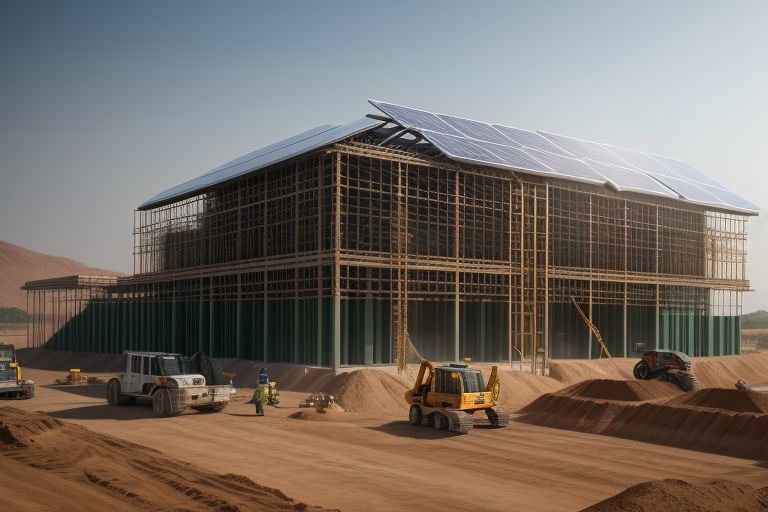
4. Economic Benefits of Sustainable Construction
Sustainable construction is not only an investment in environmental and social well-being but also offers substantial economic advantages. As the global demand for green and energy-efficient buildings grows, the financial benefits of sustainable construction become increasingly evident. These advantages include cost savings over the life cycle of a building, increased property values, financial incentives, and job creation. This section explores how sustainable construction practices can lead to significant economic gains, illustrating that environmentally responsible building practices can be financially rewarding as well.
Key Points:
a. Cost Savings:
Sustainable buildings typically offer lower operational costs due to their energy-efficient designs, water-saving features, and minimal maintenance requirements. For example, energy-efficient systems such as LED lighting, high-performance HVAC systems, and smart building controls reduce energy consumption, resulting in lower utility bills. Additionally, water-saving technologies like low-flow fixtures and efficient irrigation systems help cut water costs. Over time, the initial investment in these sustainable technologies pays off through reduced operating expenses, making sustainable buildings a cost-effective choice in the long run.
b. Increased Property Value:
Green buildings often achieve higher market values, driven by their appeal to environmentally conscious buyers and tenants. The use of durable, sustainable materials and the incorporation of energy-efficient systems not only reduce operating costs but also enhance the longevity of the building. Properties with green certifications, such as LEED or BREEAM, are increasingly sought after for their lower environmental impact and operational efficiency. This heightened demand can translate into increased property values, making sustainable buildings an attractive investment for developers and property owners.
c. Attracting Investment and Incentives:
Governments and organizations frequently offer financial incentives to encourage sustainable construction practices. These incentives can include tax credits, rebates, and grants designed to offset the upfront costs of green building technologies and certifications. For example, some regions offer tax deductions for energy-efficient upgrades or grants for renewable energy installations. These financial incentives reduce the initial investment required for sustainable construction, making it a more attractive option for developers and investors looking to maximize returns while supporting environmental goals.
d. Job Creation:
The green construction sector contributes to job creation across various fields, including renewable energy installation, sustainable design, manufacturing of eco-friendly materials, and waste management. As the demand for green buildings grows, so does the need for skilled professionals in these areas. Jobs created within the green construction industry support a workforce dedicated to building a more sustainable future, encompassing roles such as energy auditors, green architects, and sustainable material suppliers. This job growth not only supports economic development but also fosters innovation in sustainable building practices.
By leveraging these economic benefits, stakeholders can make informed decisions about investing in and promoting sustainable construction practices, aligning their financial interests with broader environmental and social objectives.
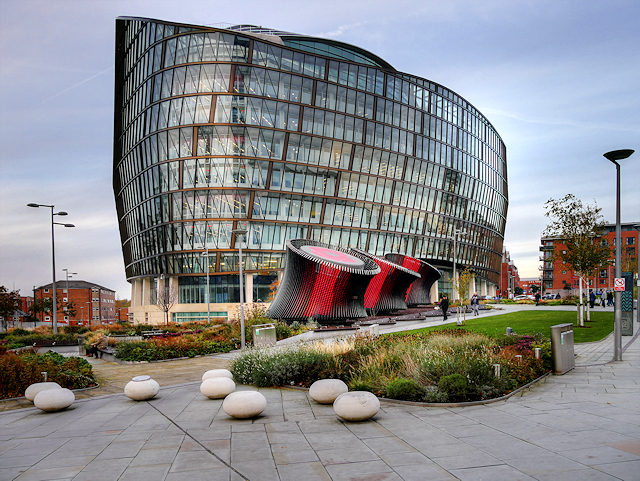
© Copyright David Dixon and licensed for reuse under this Creative Commons Licence.
Case Study Example:
Project: One Angel Square, Manchester, UK
One Angel Square, located in Manchester, UK, is an exemplary case of sustainable construction achieving remarkable economic benefits. Completed in 2014, this office building has set new standards in green building design and performance, earning multiple awards for its outstanding sustainability features.
Key Features:
- Energy Efficiency: One Angel Square has achieved an “Outstanding” energy efficiency rating under the BREEAM (Building Research Establishment Environmental Assessment Method) certification, which is one of the highest ratings possible. The building incorporates a range of energy-efficient technologies and design strategies, including advanced building management systems, high-performance insulation, and an integrated renewable energy system.
- Cost Savings: The building’s energy-efficient design has led to a remarkable 50% reduction in energy costs compared to conventional office buildings of similar size and usage. This reduction in energy expenditure is a direct result of features such as photovoltaic panels, a green roof, and innovative HVAC systems that optimize energy use and minimize waste.
- Increased Property Value: The sustainable features and energy savings have significantly increased the property’s market value. One Angel Square’s green credentials make it highly desirable to tenants and investors, contributing to higher rental income and property value. The building’s reputation as a leading example of green design has also enhanced its appeal in the competitive real estate market.
- Awards and Recognition: The building has received numerous accolades for its sustainability, including the prestigious BREEAM Award for “Outstanding” performance and several other green building awards. These recognitions underscore the success of One Angel Square in integrating sustainable practices while achieving economic and environmental goals.
Impact and Lessons Learned:
One Angel Square demonstrates how investing in sustainable construction can lead to substantial economic benefits. The reduction in energy costs, coupled with the increased property value, illustrates the financial advantages of green building practices. Additionally, the project’s success highlights the potential for sustainable buildings to attract investment and gain recognition within the industry.
By studying One Angel Square, other developers and stakeholders can gain insights into the practical benefits of sustainable design and the positive impact it can have on both financial performance and environmental stewardship.
Reflection Element:
Reflect on the economic advantages observed in sustainable projects within Kenya or globally.

5. Real-World Impacts and Future Outlook
As we conclude our exploration of the importance of sustainability in construction, it’s crucial to connect the principles and benefits we’ve discussed to the broader, real-world context. This section will delve into the tangible impacts of sustainable construction practices on our planet, communities, and economies. We’ll examine how these practices are reshaping the built environment and what the future holds for sustainable construction.
The real-world impacts of sustainable construction extend far beyond immediate environmental benefits, affecting long-term economic viability and social well-being. By assessing current outcomes and future trends, we can better understand how sustainable practices contribute to a healthier planet and more resilient communities.
We’ll also look ahead to emerging trends and technologies that are likely to shape the future of sustainable construction. From innovative materials and designs to evolving policies and market demands, these developments will influence how the construction industry addresses ongoing and future challenges.
Key Points:
a. Long-Term Impacts:
Sustainable construction is pivotal in shaping a more resilient and responsible built environment. Its benefits extend beyond immediate project goals to have lasting positive effects on both the planet and society:
-
- Healthier Environment: By minimizing resource consumption and reducing emissions, sustainable construction helps mitigate environmental degradation. This includes decreasing pollution levels, conserving biodiversity, and protecting natural ecosystems. Sustainable practices contribute to a cleaner, healthier environment, essential for the well-being of current and future generations.
- Resource Conservation: Sustainable construction practices focus on using resources more efficiently and reducing waste. This approach helps preserve natural resources such as timber, metals, and fossil fuels, which are critical to maintaining ecological balance and ensuring the availability of these resources for future use.
- Economic Growth: Long-term cost savings from energy-efficient designs and sustainable materials contribute to economic stability. Additionally, the green building sector generates jobs in various fields, including construction, manufacturing, and renewable energy, supporting economic growth and development.
- Commitment to Future Generations: Sustainable buildings are investments in the future. They represent a commitment to reducing the environmental footprint of the construction industry and improving living conditions for future generations. By adopting sustainable practices, we contribute to a legacy of environmental stewardship and responsible development.
b. Future Outlook:
The trajectory of sustainable construction is influenced by evolving trends and technological advancements that promise to drive further innovation:
-
- Growing Demand: As awareness of climate change and resource depletion intensifies, the construction industry is increasingly focusing on sustainable practices. This shift is driven by both regulatory pressures and market demands for greener, more efficient buildings.
- Technological Advancements: Emerging technologies, such as smart building systems, advanced materials, and renewable energy solutions, are set to revolutionize the industry. Innovations like Building Information Modeling (BIM) and energy management systems will enhance the efficiency and sustainability of construction projects.
- Sustainable Design Innovations: Future construction will likely see continued development in sustainable design practices, including passive building strategies, zero-energy buildings, and adaptive reuse of existing structures. These innovations aim to further reduce the environmental impact and improve the performance of buildings.
c. Global Perspective:
Sustainable construction practices are gaining momentum worldwide, with various regions leading the way in implementing and advancing green building strategies:
-
- Regional Adaptations: Different regions are adopting sustainable construction practices tailored to their local environmental conditions and regulatory frameworks. For example, Scandinavian countries are known for their high standards in energy-efficient buildings, while tropical regions focus on designs that address heat and humidity.
- International Standards and Certifications: Global standards and certifications, such as LEED, BREEAM, and the Global Reporting Initiative (GRI), are guiding and harmonizing sustainable practices across borders. These frameworks provide benchmarks for performance and help promote best practices internationally.
- Leading Examples: Countries like Germany, Japan, and Canada are recognized for their pioneering approaches to sustainable construction, including stringent energy efficiency regulations and innovative green building projects. Their experiences offer valuable lessons and inspiration for other regions looking to enhance their sustainability efforts.
Understanding the importance of sustainability is crucial as it lays the groundwork for how these principles are applied in real-world construction projects. By recognizing the environmental, social, and economic benefits of sustainable construction, you are better prepared to appreciate and implement these practices effectively.
In our next lesson, Lesson 1.3: Key Terminology in Sustainable Construction, we will delve into the specific terms and concepts that are fundamental to mastering sustainable construction. This lesson will provide you with the essential vocabulary and definitions needed to effectively communicate and apply sustainability in your projects, ensuring you can navigate the field with confidence and precision.
We look forward to continuing this journey into sustainable construction with you!

